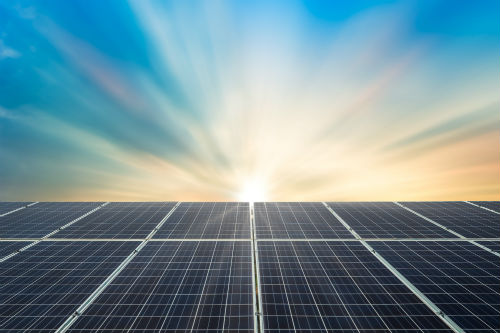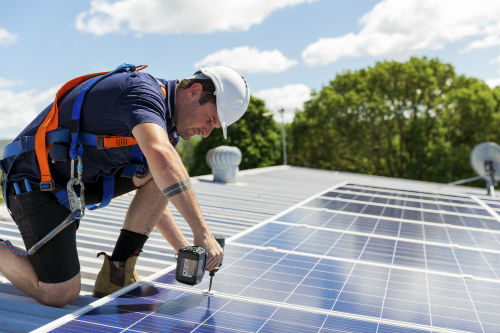Modern steel buildings are fantastic candidates for solar power generation systems that can help property owners and tenants save significantly on their electricity costs.
Depending on where you live, it’s possible to save as much as 50% (or more!) on your energy bills through the integration of a properly engineered solar power system. However, for commercial building owners, there are some limitations and considerations to address before pulling the trigger on the installation of solar panels, inverters, conduit, and other hardware. One of those considerations is the type of roof that the panels will be installed on.
Capital Steel Industries specializes in providing high-quality, engineered steel buildings and contracting services that are ideally suited to a broad range of commercial and residential applications.
When it comes to adding solar panels to a flat or low-slope roof, there are virtually no mechanical reasons why this can’t be done. Problems start to arise when high-pitch or steep-sloped roofs are considered, which changes things considerably.
Steel Building Rooftop Types: Corrugated vs. Standing Seam
For metal buildings, the two most common roof types are corrugated and standing seam.
Corrugated metal sheeting requires the use of exposed fasteners to affix the metal to the roof underlayment. On the one hand, this roof type installs quickly and is very cost-effective. On the other hand, because the fasteners are exposed to the elements, corrugated metal roofs need to be inspected every 3-5 years or so to ensure that they are still providing optimal protection for the building.
Standing seam roofing is arguably much more attractive, design-wise. The evenly spaced, low-profile seams that connect the metal sheets make for a pattern that works well with most building types.

Even though standing seam roofs can be more expensive than corrugated metal roofs, they use a concealed fastener system that is much more durable over the long term.
So, which of these roofs are best suited for solar panels? The good news is that both of them are.
Installing Solar Panels on Corrugated Roofs
One solar PV mounting system manufacturer, SnapNRack, has developed a ‘universal’ solar panel mounting solution that can be used with virtually any metal roof type, including corrugated.
This system does require the roof to be penetrated and for a fixing bolt to be secured to the subroof. However, a watertight seal at the base of the mount prevents water ingress. Unless the slope of the roof is abnormally steep, there are no issues with installing solar panels on corrugated metal roofs.
Installing Solar Panels on Standing Seam Roofs
Outfitting a metal roof with solar panels is made much easier and more effective when it’s a standing seam roof. Why? Because the seams themselves act as the anchor points. This means there is no roof penetration required for the mounts themselves.
Check out AceClamp, a supplier of industrial-grade solar PV mounting systems. This solution uses a simple, straightforward bolt clamp to secure the panels to the standing seams, using the strength of the steel sheeting to support the panels. Not only is this less intrusive, but the panels are easier to remove for repositioning or maintenance purposes.
Membrane-Based and Asphalt Shingle Roofing Systems
Some steel buildings make use of TPO, PVC, or other latex membrane roofs. These types of roofs can present challenges for the installation of traditional PV solar modules. However, thin-film solar is a fantastic alternative. MiaSole is one manufacturer that provides ultra low-profile, thin-film solar modules that are directly bonded to the roof membrane itself. This maintains the waterproof integrity of the roof while giving the property owner the advantage of being more energy independent.
When it comes to asphalt shingled roofs, things can get dicey. The reason for this is because shingled roofs are much less durable over the long term when compared with true-to-form metal roofs. Even though asphalt shingles work great for high-slope roof types, installing solar on these roofs requires penetrating or even outright removing some shingles to make room for the mounting hardware.
When the time comes for an asphalt shingle roof to be serviced (after a hailstorm, for example), complete removal and reinstallation of the solar panels will be required, which can be quite costly.

Capital Steel Industries is proud of our network of highly qualified, certified steel building contractors.
If you’re in the market for a new steel building and you need a competent, professional contractor to assist you, contact us today and let’s start a conversation.


